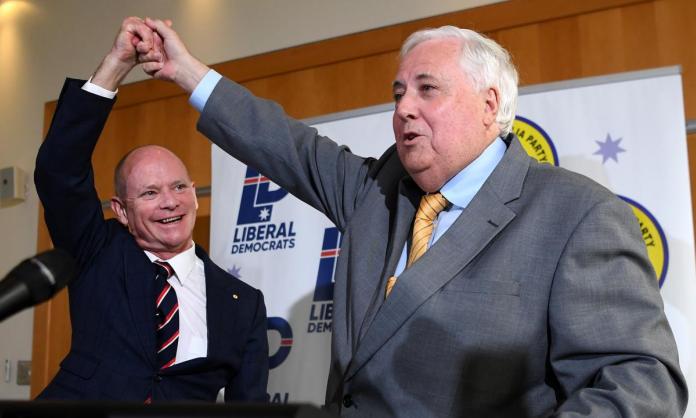The media have focused overwhelmingly on the teals’, and to a lesser extent the Greens’, ability to harness popular disillusionment with the two major parties. Much less attention has been paid to the disturbing rise of support for a plethora of far-right parties and independents in this election.
While the far right did not win a swathe of new seats, Pauline Hanson will be returned to the Senate and, at the time of writing, Victorian real estate agent Ralph Babet could still win a Senate seat for Palmer’s United Australia Party on the back of Liberal preferences. Babet, an anti-vax “freedom movement” conspiracy theorist, argues that the World Economic Forum is carrying out a globalist takeover of Australia’s sovereignty and that drinking blood is a new trend on the left.
When you compile the total vote in the House of Representatives for the eight or so far-right outfits, they were clearly the main beneficiaries of the swing away from the major parties. With around 20 percent of ballots still to be counted, the far-right vote was up 4.7 percentage points to 11.6 percent. This does not include a 0.4 percent vote for Katter’s Australian Party, which arguably could be included in the far-right total given that Bob Katter praised the fascist Proud Boys and called for a vote for Hanson in seats he did not contest.
These far-right gains compare with gains of 1.3 percent for the Greens and 2 percent for independents—and that includes not just the teals but various far-right independents who commonly were more brazenly fascist than parties like the UAP.
Take, for example, the Liberal-held seat of Casey in Melbourne’s outer south-east, where the UAP is on nearly 5 percent, One Nation 3.2 percent, the Liberal Democrats 2 percent, the Federation Party 0.7 percent and far-right independent Craig “Pitbull” Cole 3.7 percent.
Cole, a former wrestler, was one of the organisers of the anti-vax “freedom” protests. He believes that the country is run by a secret cohort of paedophiles. At the far-right Convoy to Canberra, Cole declared that Parliament House is where “all the gutless rock spider paedophiles congregate”. According to a report in a local newspaper, Cole said that, if elected, “Your maiden speech is supposed to be all warm and fuzzy, but stuff that. I’m going to get out the M60 and mow every single one of them down”.
Then there is Riccardo Bosi, a former special forces army officer, who is on 3.3 percent in the western Sydney seat of Greenway on top of 4.2 percent for the UAP, 2.8 percent for the Liberal Democrats and 2.5 percent for One Nation. Bosi, another “freedom movement” organiser, calls for the execution of politicians and claims that COVID-19 vaccines contain AIDS.
There are large far-right votes in a wide range of urban and rural seats, including 24.5 percent in the Queensland seat of Wright, 22.8 percent in the Sydney seat of Werriwa, 21.4 percent in Hanson’s old stomping ground of Blair, 20.6 percent in the rural Queensland seat of Maranoa, 20 percent in the Northern Territory seat of Solomon, 19.2 percent in the South Australian seat of Spence, 18.5 percent in the Melbourne seat of Bruce, 18 percent in the Sydney seat of McMahon, 17.7 percent in the rural NSW seat of Lynne and 15.8 percent in the WA seat of O’Connor.
Both the UAP and Hanson’s One Nation oriented heavily towards the milieu around the “freedom rallies”, and both parties ran a number of candidates with a record of involvement in openly fascist or “white power” organisations, including Victor Waterson, the UAP candidate for Bennelong, a former member of the Nazi Australia First Party.
The Liberal Democrats, which also strongly backed the anti-vax protests, ran on a program of climate change denialism, a 20 percent flat tax for incomes above $40,000 to benefit the rich, the slashing of company taxes and opposition to the funding of public schools.
The less well-known far-right parties include the Great Australian Party, established by Rodney Culleton, a former Senator for One Nation; the Australian Federation Party, a right-wing Christian outfit that is anti-abortion, anti-vax and anti-mask; and the Australian Citizens Party, formerly the Citizens Electoral Council, which combines climate change denialism with anti-Semitic, anti-gay and anti-Aboriginal stances.
The Informed Medical Options party, which is anti-abortion, pro-small business, anti-vax and hostile to the World Health Organization, also backs the old fascist shibboleth of opposition to fluoridation of the water supply. In March 2020, prominent party member Tom Barnett, who ran for mayor of Byron Bay, reportedly proclaimed: “You can’t catch a virus; it’s impossible ... the only way that you can catch a virus is by having it injected into your bloodstream”.
Last but not least is the Australian Christians, which got more than 2 percent of the Senate vote in Western Australia on an anti-vax, anti-abortion and anti-Safe Schools platform.
The far right clearly benefited from their involvement in the anti-vax “freedom” rallies. Worryingly, they picked up substantial numbers of migrant working-class votes from Labor in the outer suburbs of Melbourne. Many poorer people in these suburbs felt absolutely abandoned by the lack of adequate financial and social support during the long lockdowns.
But it was not just in traditional Labor-voting working-class suburbs that the far right did well. They got substantial votes in pretty much all the outer suburbs of Melbourne. They had combined votes of 14.7 percent in Liberal-held Latrobe as well as support in the regions: 17.5 percent in Gippsland, 16.8 percent in Mallee and 14.7 percent in Nicholls.
The far right’s increased vote cannot be explained just by hostility to the state Labor government’s pandemic lockdowns. In the Senate, the far-right vote was highest in Queensland (16.9 percent) followed by the Northern Territory (13.4 percent), Western Australia (12.3 percent), New South Wales (11.4 percent) and then Victoria (11.1 percent).
This reflects growing disillusionment with the capitalist status quo brought on by cost-of-living pressures, insecure work, the lack of affordable housing, the crap state of the health system, rampant privatisation and falling wages and the abject failure of the unions and the Labor Party to stand up for the rights of working-class people. Australia is catching up with an international trend reflected in the support for Donald Trump, the fascist Le Pen in France and the far right across most of Europe.
Of course, not all the far-right voters are ideologically hardcore racists or fascists. The great bulk of them are not about to become fascist street fighters anytime soon. In part, the far right attracted a protest vote from people fed up with the rotten neoliberal status quo and the bankrupt mainstream parties.
Some of the far-right parties downplayed racism. That helped the UAP and to a lesser extent Hanson gain a substantial vote amongst some migrant communities in the outer suburbs of Melbourne and Sydney.
All of this simply underlines the urgency of building a socialist alternative that stands up for the rights of workers and all the oppressed. We need a militant left that can put forward positive collective working-class solutions to the problems that have attracted bitter and angry people to the far right.
Fortunately, as yet the Australian far right are splintered into a series of often bitterly competing small outfits and have not been able to cohere behind one authoritative leader like Trump or form a powerful party like the National Rally in France. This gives the left time to organise to confront them and prevent them cohering their voting base into a fighting street movement.
The danger, however, is that a weak Labor government that rules for the big end of town and does nothing to address all the serious problems confronting working-class people—from sharply declining real wages to housing affordability, the soaring prices of basic necessities and the running down of basic public services—can provide fertile ground for the far right to gain a broader audience for their reactionary “solutions”. There is no room for complacency. We need to seriously organise.









